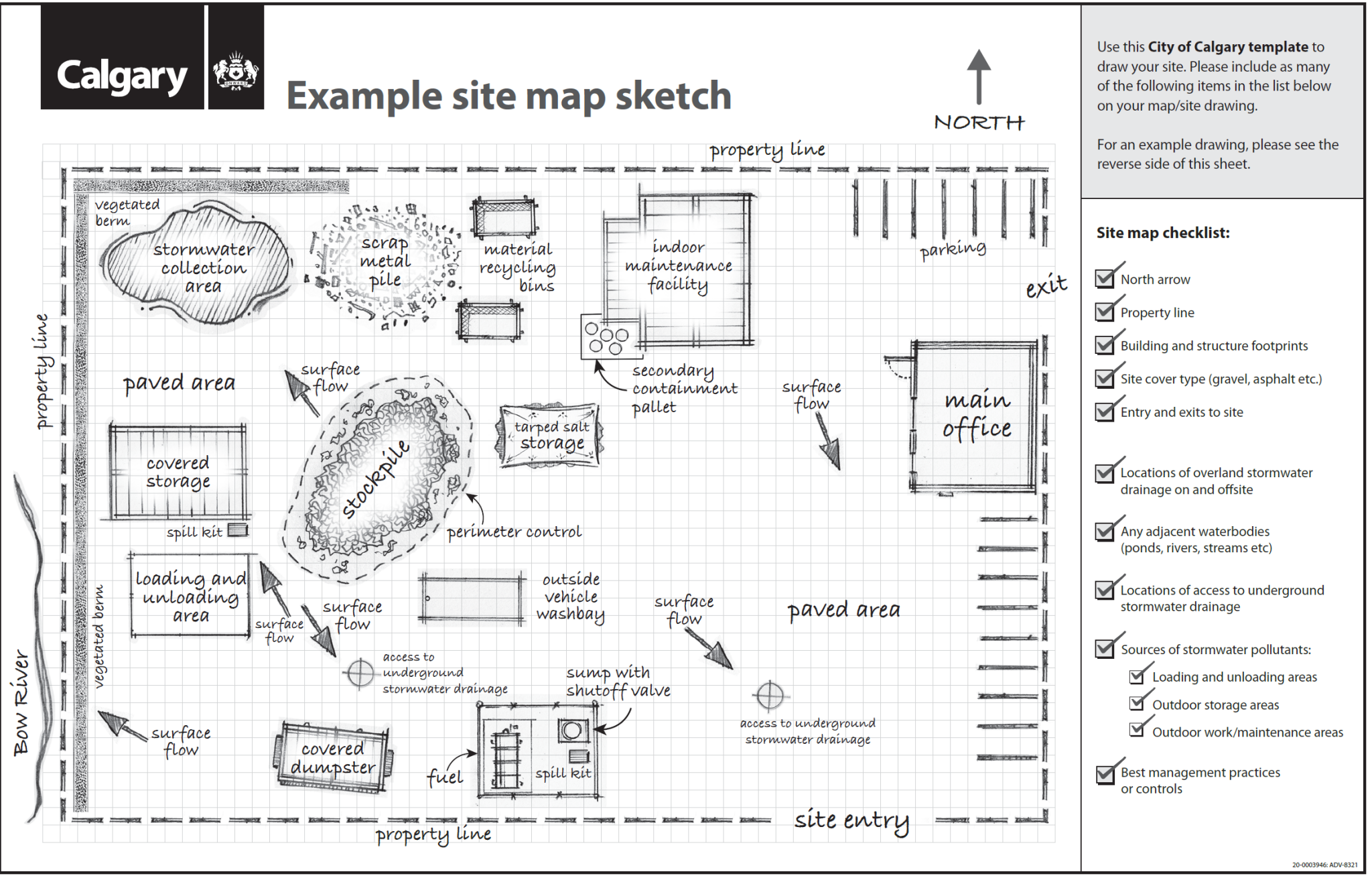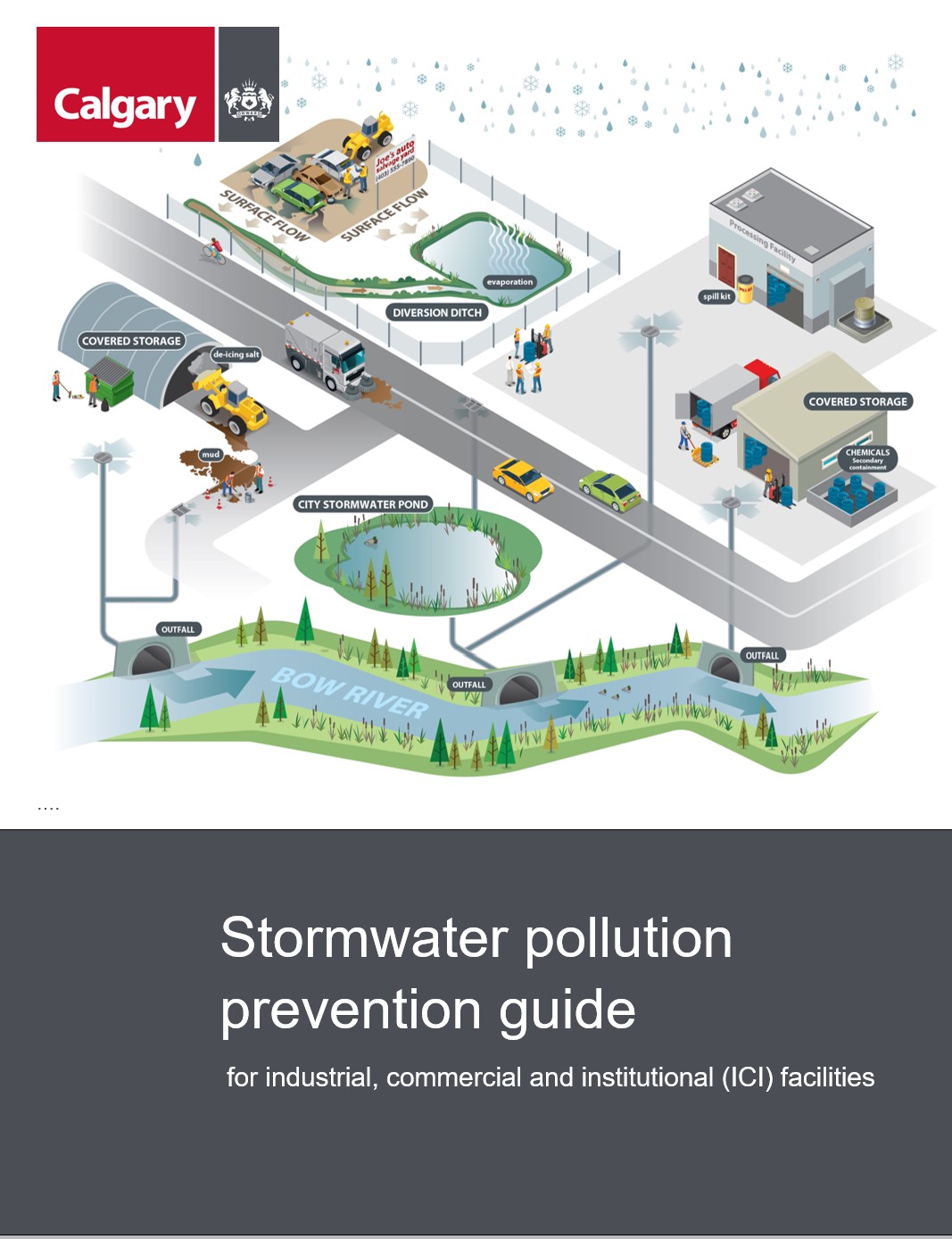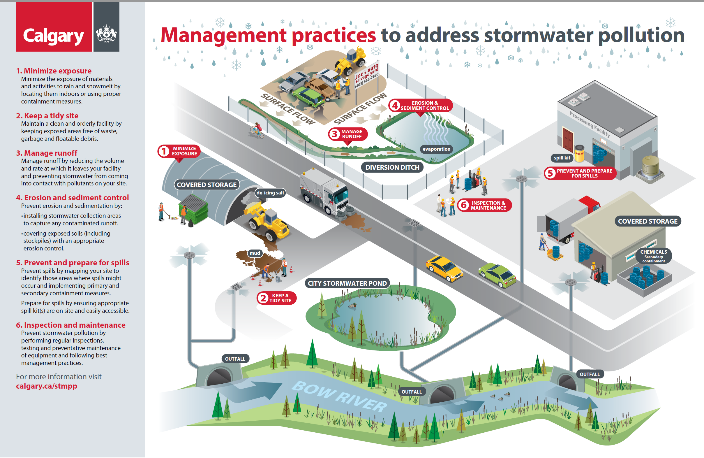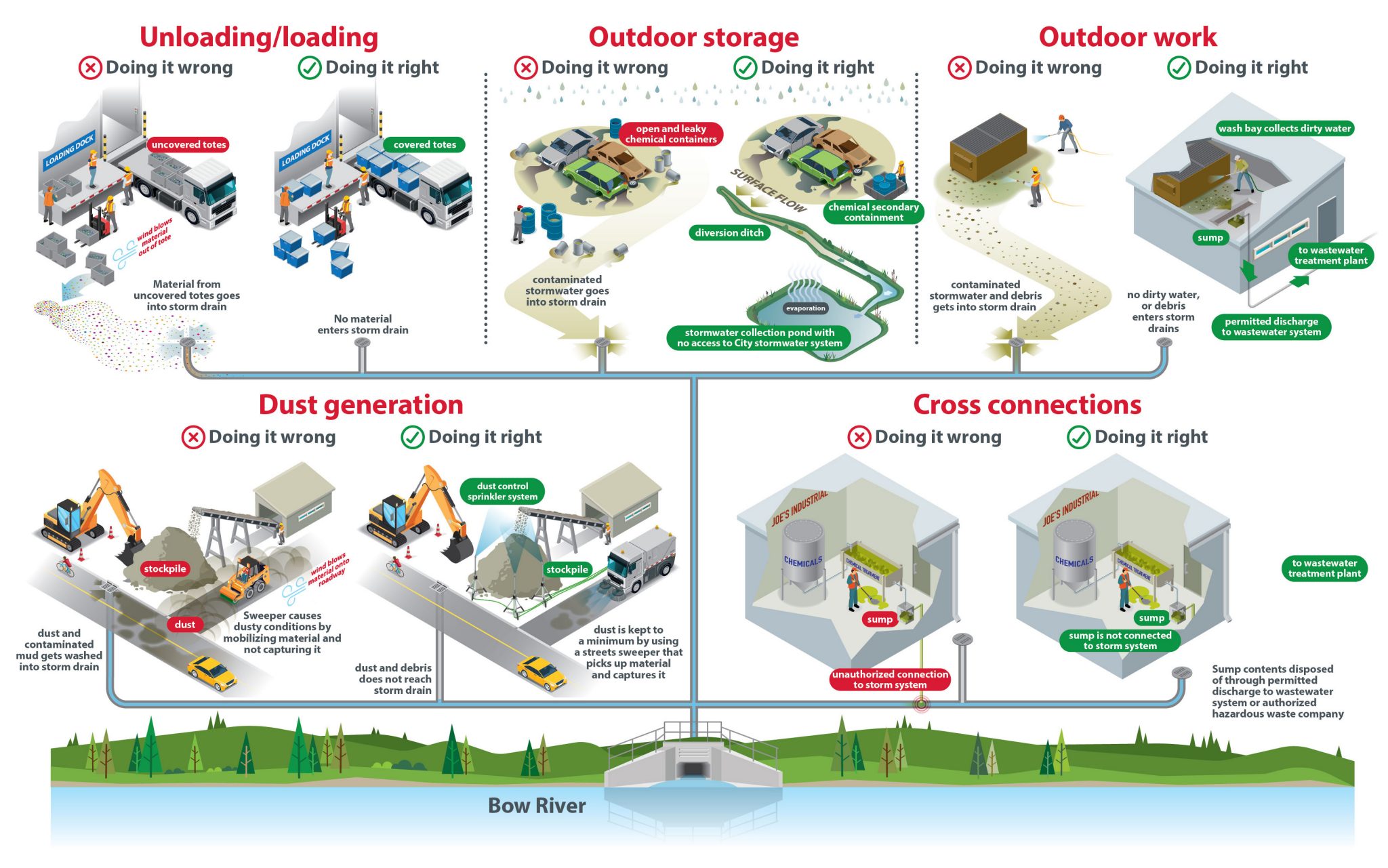Stormwater pollution prevention for industrial, commercial and institutional facilities
Industrial, commercial and institutional (ICI) facilities are those businesses that perform a portion of their activities in outdoor areas exposed to the elements (e.g., material storage, handling and processing, vehicle fueling and maintenance, shipping and receiving). Every time it rains or snow melts, the outside areas of industrial, commercial, and institutional facilities get a bath. Dirt, oil, gasoline, garbage, and chemicals are washed into storm drains.
Stormwater and the pollutants in it flow into our rivers through outfalls – the concrete drains you see along the river. Polluted stormwater can affect the health of our streams, rivers and the land surrounding them, as well as the health of the wildlife and fish that rely on them. We all have a shared responsibility to control both the amount and quality of stormwater released into our rivers.
There are practical, cost-effective ways that every business can reduce the potential for polluting stormwater runoff.
Map your site
Mapping your site will help you and your employees identify how your property connects to the storm system, potential problem areas and actions you can take to help minimize or remove the risk of polluting stormwater runoff.
- Know where the storm drains are on your property and mark them with a stencil to remind staff that these areas lead directly to the river.
- Create a site map showing all buildings, structures, paved areas and parking lots, where your property connects to the storm system and areas that are potential sources for stormwater pollution. Download instructions and a checklist and template.
- Conduct an internal audit to identify correctable issues and prioritize areas of focus.
- Train staff in best management practices in spill prevention and response.
Sample site map. Download a checklist and template to gets yours started.
Download the Stormwater Pollution Prevention Guide for Industrial, Commercial and Institutional (ICI) facilities
Best management practices to address stormwater pollution on your site
Reduce the risk of stormwater pollution by keeping your facility well-maintained. Establish management practices to reduce mishandling of materials and equipment, maintain clean and orderly facilities and train your employees in good housekeeping practices.
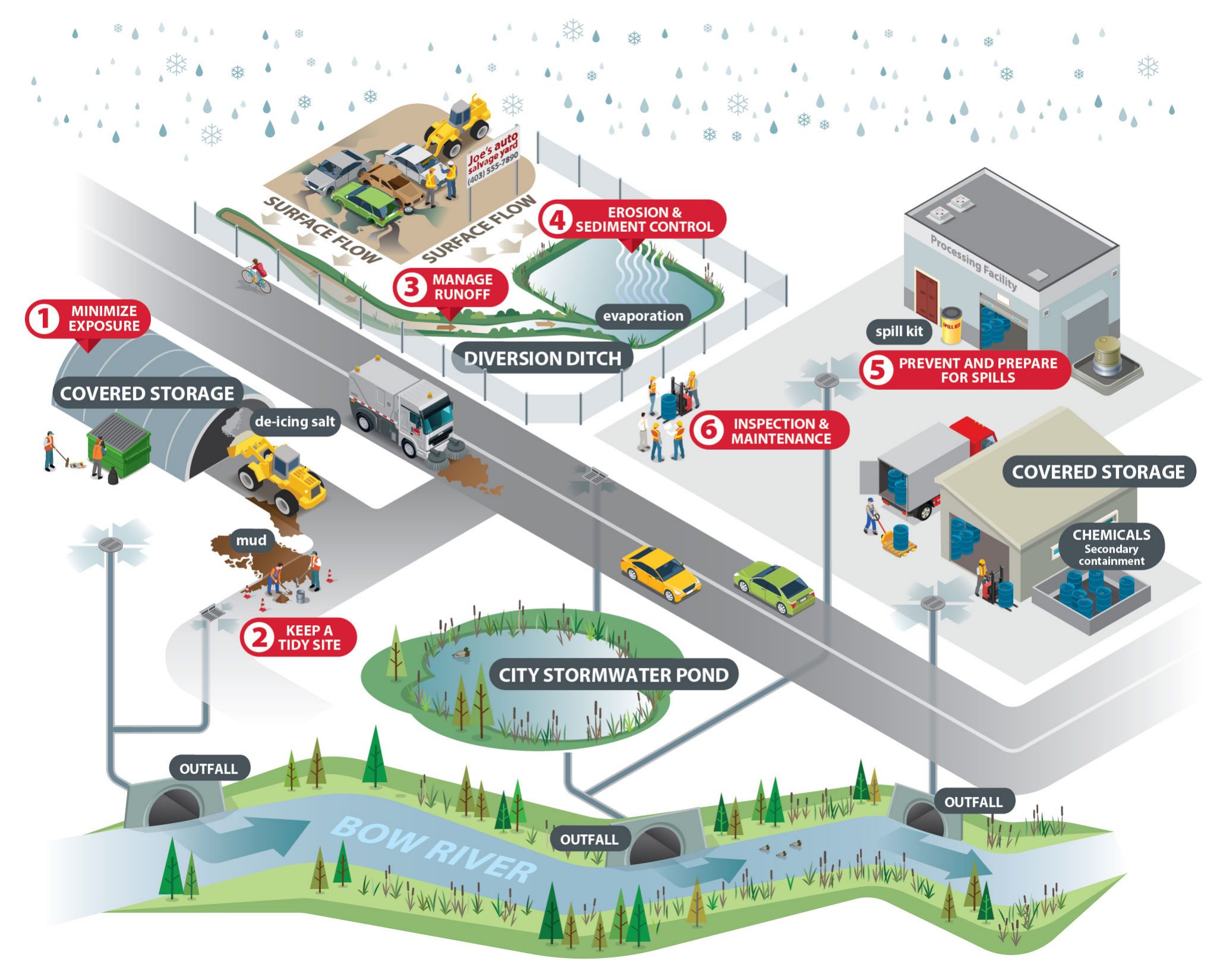
1. Minimize exposure
Minimize the exposure of materials and activities to rain and snowmelt by locating them indoors or using proper containment measures.
2. Keep a tidy site
Maintain a clean and orderly facility by keeping exposed areas free of waste, garbage and floatable debris.
3. Manage runoff
Manage runoff by reducing the volume and rate at which it leaves your facility and preventing stormwater from coming into contact with pollutants on your site.
4. Erosion and sediment control
Prevent erosion and sedimentation by:
- installing stormwater collection areas to capture any contaminated runoff.
- covering exposed soils (including stockpiles) with an appropriate erosion control.
5. Prevent and prepare for spills
Prevent spills by mapping your site to identify those areas where spills might occur and implementing primary and secondary containment measures. Prepare for spills by ensuring appropriate spill kit(s) are on site and easily accessible.
6. Inspection and maintenance
Prevent stormwater pollution by performing regular inspections, testing and preventative maintenance of equipment and following best management practices.
Download this information as a printable poster and share it with your staff as a reminder of how to reduce stormwater pollution on your site.
Inspect your best management practices as frequently as is needed for your site. The recommended frequency is every seven days. Use this site inspection form to document your site inspections and any maintenance performed.
Prepare for and prevent spills
Have a plan to prevent spills from happening:
- Map your site to identify locations for possible spills and cost-effective containment. There are many liquid and solid materials that can become pollutants. Inventory your business to know which spillable materials are stored on site, including applicable details on delivery/production, storage, handling and disposal. Spillable materials are often liquids but can also include other materials.
- Make sure you have primary and secondary containment.
- Primary containment is the receptable in which the substance or material is contained during normal operations.
- Secondary containment provides temporary containment of any substance or material until the appropriate spill response is implemented.
- Inspect and maintain primary and secondary containment as well as other best management practices.
Develop and practice a spill response plan:
- Have clearly labelled, fully stocked spill kits easily accessible anywhere your business uses liquids. A spill kit is the quickest way to stop a spill from becoming a bigger, costlier, problem. Spill kits will vary, depending on the potential pollutants you have at your facility but will include:
- Absorbent material
- Waste disposal containers
- Personal protective equipment (PPE)
- Know when to report spills and request emergency assistance.
If you have a spill or leak:
- Call 9-1-1 if you can’t contain the spill or if it seeps into soil or flows to a gutter or storm drain.
- Call the City of Calgary (311) for spills that enter City infrastructure or property
- Call Alberta Environment and Parks (1-800-222-6514) to report spills that have or could harm the environment (air, soil, groundwater, or surface water).
- Ensure you have accurate information on the type and quantity of substance spilled, and where it occurred.
Download the spill management and response sheet for more information.
Address the most common pollutant sources before they become a problem
Runoff from areas where industrial and commercial activities occur can pick up and transport pollutants (e.g. heavy metals, oil and grease, garbage, salt, sediment). Activities such as vehicle storage and maintenance, material handling, and salt storage are often conducted in outside areas exposed to the elements. Accidental spills and leaks, improper waste disposal, and discharges of chemicals or waste to storm inlets are also common sources of stormwater pollution. There are five common categories of outdoor activities that can be major sources of stormwater pollution.
- Loading and Unloading: Transfer of materials to a facility (e.g. by pump, conveyor, forklift transfer of containers) can result in spillage. Accumulated materials can be washed away in runoff.
- Outdoor Storage: Materials such as fuel, raw materials, process residuals, and waste are often stored in containers, on platforms or pads, or stockpiled. Some materials are carried or dissolved in stormwater runoff.
- Download an information handout about outdoor storage of used cooking oil.
- Outdoor Work: Activities such as outdoor vehicle and equipment maintenance, equipment washing, and concrete mixing can result in material spills which run directly into the stormwater system or are transported in runoff.
- Dust Generating Work and Facilities: Dust generated during industrial processes as well as process residuals and exposed soil at the facility can become wind-borne. Stormwater runoff can erode and transport sediment, dust and other fine material.
- Cross connections to the stormwater system: Sometimes facilities have known or unknown connections to the stormwater system which allow liquid waste or other process material to be discharged directly or indirectly into to stormwater system. These discharges often contain materials that are prohibited under The City of Calgary’s Stormwater Bylaw (37M2005).
There is a right way and a wrong way to deal with pollutant sources.
There is a right way and a wrong way to deal with pollutant sources. Download this printable poster to find out ways to manage the most common pollutant sources in your business.
Devices that capture or absorb pollutants before they escape your facility can be a useful last line of defense. The use of these devices on privately-owned and publicly-owned storm inlets is regulated by The City’s Stormwater Bylaw (37M2005). Download guidelines on the use of inlet protection devices on, or within storm catch basins and manholes at industrial, commercial, and institutional (ICI) facilities.


